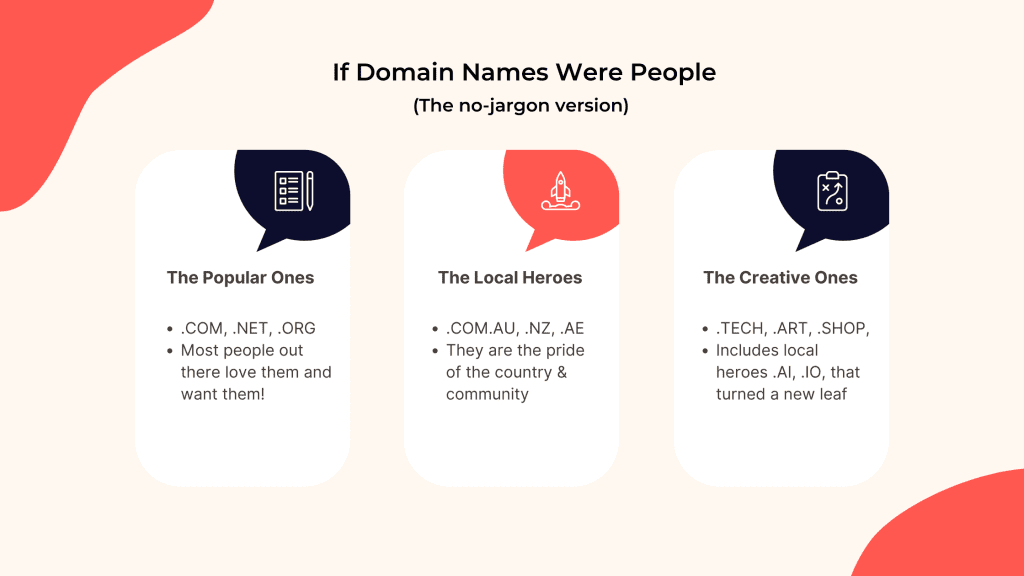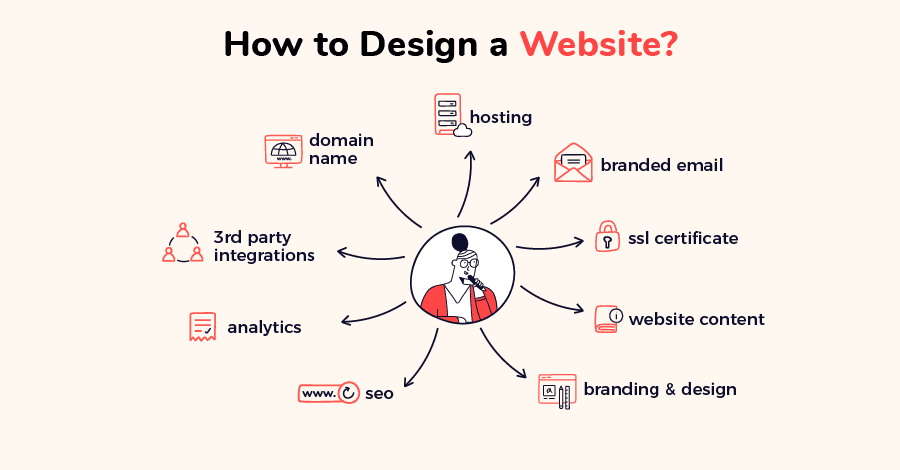Welcome to the Online World! You’ve probably noticed already, but these days everything is digital. Getting online isn’t so much a choice as a necessity now — especially since online purchases and services are growing year-on-year. Even if your hair salon needs customers to physically come in (digital haircuts aren’t a thing… yet!) you can massively bump your visibility & appointments by having your own website. After all, the first thing most people do when they want to buy or do something is google it.
81%
Retail shoppers look online before they buy7 hours/day
Time spent online by an average users27.6%
Of the global population made an online purchase in 2023
Those are some serious evidence showing the importance of having an online presence for business growth and success.
In this step-by-step guide, we’ll give you a run-through of everything you need to know to get the job done right and make it a success. These tips can be used for any type of business – be it a one-man army or one with 35+ employees.
Step 1: It All Starts With a Name
The first thing you’ll need for your professional website is a domain name. Your domain name needs to be unique and reflect your business website. If your company’s name is available as a domain “as-is”, go get it!
- Buy a .com domain that matches your brand & business name
- If you cater to local customers go with a country-specific domain like .au, .nz, .ae, .uk or get super specific with .melbourne, .sydney or .miami

But What if it’s Not Available?
Global domains like .com are universally recognised, but so many are already taken that you may not be able to get the one you want. If that’s the case, here are some options for what you can do to remedy the situation:
- Add a verb to the beginning of your company name, if it makes sense — like drinkcarlascoffee.com would be suitable for Carla if she wanted a .com for her cafe.
- Explore new domain options to see what alternatives might work well (like Carlas.coffee). Country-specific domains, for example, can offer up great domain hacks. No, not actual hacking. Think of it as building words out of the bit at the end, like Portfol.io.
- Add your location, if you’re a local business — henryshardwaresydney.com or henryshardwares.sydney tells people that Henry’s hardware store is in Sydney, which is probably where his target customers will be too. Who drives across the country for a tin of paint?
- Try to buy your desired domain. Contact the current owner and see if they’d sell it to you.
If you want a better idea of your domain options, we’ve got a great guide to different types of domains.
What Does it Cost?
Prices can vary depending on what you choose. A domain is a subscription service (similar to your Netflix or Amazon Prime account), you can buy your domain name for 1 to 10 years. Some can be as little as $10 per year, while others might be $25+.
Want to see how much it could be? Take a look at our comprehensive price list.
Read more:
Step 2: Plan Your Website
Building a website’s like building a house. You need a blueprint or the whole thing could become a confusing labyrinth, or worse, you could forget something important: like a door.
You should also work out exactly what you want to achieve. Is it to sell products, get more inquiries, create brand awareness, or just give people interesting stuff to look at? And of those potential customers, how do you think they want to use your new website? Getting these right can make a big difference to your website’s success.

Here’s what to consider when planning your site:
1. Website Pages
List the pages you want. Think about what will benefit your customers or audience. Here’s a list of commonly used website pages:
- Home page – your digital storefront, showing people who you are and what you do
- Shop and product pages – if you’re selling things
- Booking page – if you offer appointments or consultation meetings
- About page – to talk all about yourself and your business — tell people your story
- Blog section – for longer written content about your industry and related interests
- Portfolio page – for showing off your work, if that’s your bag
2. Information Architecture
Information Architecture (IA) is a key part of website design. This means connecting all the pages your website needs. You could use a simple flowchart-style map for this.
Mapping out a clear and simple IA is important because it lets you see where your pages will go.
3. Write Your Content
You’ll need relevant and useful written content that gives visitors the information they’re looking for. Always consider your target audience and your own online experiences — what works for you will probably work for them too!
Your website’s also a great opportunity for you to share your story of how it all started and show the people behind the business. Your products and features will do the job of converting users but your people and story actually help build customer trust.
4. Design and Imagery
People love a good-looking website. So, try to find the right theme, template and images to make yours look the way you want: whether that’s cool and professional or cosy casual, you know what’s best.
Where to Find the Best Images?
Use paid services like Adobe Stock or free ones like Unsplash, Pexels to find collections of related images to maintain a consistent theme and style throughout.
Not sure how to pick the right photos for your website? We’ve got you covered.
If you’ve got an actual shop and an eye for photography (or a friend that loves photography), snap a few photos of your store, and people. No stock photos can come close to showing the real people & business.
Themes
Shopify is a great example of eCommerce done right. Its clean design uses muted colors and lots of space to allow the content to speak for itself. The images are consistent, showing features of their product or real-life people doing their thing.
There are thousands of themes available for you to choose from, so when considering options think about what best reflects your business.
5. Website Functionality (aka, Your Main Goal)
Go back to your plan, look through your list of web pages, and list all the functionality you’re going to need. This is VITAL for the next stage: building your website.
If you need to include an appointment scheduling software or online payment system, you have to ensure your website will actually have that functionality.
6. Sense Check
The plan’s done, but you’re not! It’s time to check. Go back through everything to make sure you haven’t missed anything important.
Ask yourself, does your plan allow you to do everything you want your website to do?
Have you added anything you don’t really need or want? Cut it out! Don’t bother with the clutter — it’ll be a pain to maintain and won’t benefit visitors.
Read more:
Step 3: Build Your Website
To build your website you’ll need to find a host (where your website content will be stored online) and a content management system (CMS) which is the platform you use to create and manage your website, like WordPress or Wix.
There are loads of CMS and hosting options out there, but often your domain provider will have a quality offering too. This is a good place to start because then everything is under one roof.
Remember to always keep your list of the necessary functionality in mind, though. Whatever options you go with, don’t compromise on the things that are vital for success.
A shared hosting plan can cost you anywhere between $2.99/mo to $20/mo depending on how much web space you are after.
DIY or Hire a Pro?
That’s a tough question. It really comes down to how fancy you want your website to be (and how hot your tech and web design skills are).
Many CMS platforms are super easy to use, so you can build a quality simple website yourself without much training (though maybe watch a few YouTube tutorials) but for more advanced custom features, you may need the help of a web developer.
You’re going to need to maintain and manage your website into the future, so however, you get it built, factor in if you’re going to need help looking after it over time.
Just one more thing to remember…
Be Mobile-Friendly!
These days 62% of website traffic comes from mobile devices, and that number isn’t getting smaller. So having a CMS or theme that is responsive (i.e. automatically adapts its design to tablets, mobile phones, and larger screens) is going to make your website look good on all devices.
Read more:
Step 4: And finally… Business Email
Having a website without a professional email is like wearing a tuxedo with shorts. While that may work on a Zoom call, it’s not ideal for a business. Your new customers expect to see an official-looking email address on a contact page, rather than a ham-fisted Gmail address. It shows them you know what you’re doing and that you’re legit.
You’re less likely to trust us if we emailed you from OnlyDomainsSupport@gmail.com instead of support@OnlyDomains.com
74%
Consumers trust businesses that use professional email addressesOnly 39%
Trust businesses that use a free email address, such as Gmail or Hotmail
Once you’re done with creating your website, create a business email account to connect to inquiry forms and include them on your contact page.
Read more:
Step 5: Set Up Essential Services
To achieve your goals, you’ll want to create any additional functionality before launching it. These can be linked to your operational systems making it easier for you to run your business and making you look awesome to your customers.
Booking Systems and Calendars
Businesses that offer sessions or appointments will want customers to book time slots. Anything from hair salons to lawyers and dentists, where scheduling is key to providing your services, will need an online calendar so people can book a day and time through your website. Services like Appointy or Calendly can be added to your website to make this a doddle.
Maps
If you’ve got a physical store or premises you want people to visit, using map embedding features on your contact page allows you to show people exactly where you are. This is included in most CMS now, so you won’t need a plug-in or additional app for it.
Contact Forms
Whatever your business, giving customers a way to easily reach you through your website allows you to connect and build relationships. This is also a great way to collect contact details of users interested in your products or services. You can reach out to them when you have a new product or a seasonal sale.
Social Media Accounts
Your social accounts can be linked using recognisable icons in the footer and on the contact page of your site. If you don’t have them already, set up a Facebook page, Twitter, Instagram, LinkedIn, or YouTube account to build connections, promote your business and give customers convenient ways to contact you.
Payment Methods
If you want your business to make any money, it’s kinda important that you have a way to get paid. Whether it’s ordering a pair of handcrafted earrings, booking a massage, or getting a subscription to a gym, you need a payment service.
PayPal may be great for bigger organisations. Entrepreneurs and local businesses can use add a QR code or use Google Pay, ApplePay for simple payment processing.
Order Management
After orders are placed, you’ll need to get them processed and shipped. Different types and sizes of businesses will do this in different ways, so finding a system that works for you is pretty important. If you’re DIY-ing it, packing up, and sending things yourself, you won’t need such advanced systems, but apps like Webgility give bigger operations a great way to get order details through to packing and warehousing.
Test, Test, Test
Once you’ve got everything up and running, it’s time to launch your website! Just make sure it’s all working properly first. Test every function and review sites using different computers and devices to ensure it’s operating as they should — the last thing you want is to have your first visitors hitting dead ends.
Read more:
Step 6: Promote Your Website
Now you’re live and online, you can sit back and– no of course you can’t relax. You’ve got to get out there and promote your website to get more visitors and bring in that business. There are plenty of ways to do this, both on and offline:
Get on Google My Business
Create a Google Business Profile so you can set your business location and make it easier to find you in local searches. This is particularly useful if you have physical premises you want locals to find and visit. And it’s completely free.
Get Analogue
Flyers, posters, and business cards are great marketing tools to promote your website and business. Send them out and keep them in your store so customers know they can also find you and your services online.
Never underestimate the power of word-of-mouth, either. Tell everyone to tell everyone. (This is why having a simple domain name is handy.)
Promos and Offers
Come up with some simple promotions and offers for people who buy in-store to encourage them to check out your website and buy online. Discounts on their first online order, or if they refer a friend who then buys something, are great ways to encourage business and spread the word.
Ads
If you have the capital for it, invest in some digital marketing to get your website in front of people looking at related things online. Online ads can have a great return on investment (ROI) when it’s done strategically.
SEO
Search engine optimization (SEO) uses relevant targeted keywords and other techniques to increase your search rankings and get you further up the page of Google results. There are plenty of simple tricks to boost your SEO performance, many of which you can do yourself, but you can also consult a specialist if you want to take it to the next level.
Read more:
Final Thoughts
Taking your business online is a great way to increase outreach, get more sales, explore new opportunities and flex your creative muscles. If you’re not online yet, it’s basically the best thing you can do for your business.
Just remember that Rome wasn’t built in a day, and neither is a quality website. There will inevitably be things you’ll want to change once it’s live as you learn what does and doesn’t work for you. Be patient with it, and be ready to adapt and change to get it right.
Here’s Some Inspiration
We’ve scoured the internet to find a few of our favorite examples of well-made websites from a variety of industries to give you an idea of what’s possible with the right combination of design, pagination, content, colour, and imagery. Check these beauties out!
Not Sure Where to Start?
Not a problem. We can help you get started on your journey to taking your business online today. OnlyDomains is a great place to start.
Sources
- https://www.invoca.com/blog/retail-marketing-statistics
- https://www.oberlo.co.uk/statistics/how-much-time-does-the-average-person-spend-on-the-internet
- https://www.weare.ie/consumer-trust/
- https://www.oberlo.com/statistics/how-many-people-shop-online
- https://explodingtopics.com/blog/mobile-internet-traffic
